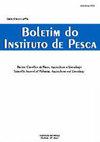共轭亚油酸饲喂期对冬芪脂肪酸分布及营养品质的影响
IF 0.6
4区 农林科学
Q4 FISHERIES
引用次数: 0
摘要
研究了不同时期饲粮中添加共轭亚油酸(CLA)对阿芪胴体脂肪酸分布和营养品质的影响。试验采用完全随机设计,分为8个饲养期(0、7、14、21、28、35、42和49 d)和4个重复。将240尾鱼(3.4±0.3 g)分配到4个水族箱中,分别饲喂含32%粗蛋白质、15 MJ kg-1总能和2.5% CLA的饲料。饲喂CLA饲粮49 d, CLA、CLA异构体和二十二碳六烯酸(DHA)的沉积量增加。同分异构体c9、t11比t10、c12沉积量大。多不饱和脂肪酸(PUFA)、n-3和n-6随着饲喂期的增加而增加,而饱和脂肪酸(SFA)、单不饱和脂肪酸和中链脂肪酸则减少。PUFA/SFA比值、DHA/EPA、EPA+DHA、血栓形成指数呈线性增加。在动脉粥样硬化指数降低的同时,低胆固醇/高胆固醇比值呈二次效应增加。n-6/n-3比值无显著差异。添加2.5%的CLA至少饲喂35天,可改善天牛的脂肪酸结构,并提供具有良好营养品质和功能效益的商品产品。本文章由计算机程序翻译,如有差异,请以英文原文为准。
EFFECT OF CONJUGATED LINOLEIC ACID FEEDING PERIODS ON FATTY ACID PROFILE AND NUTRITIONAL QUALITY OF Astyanax altiparanae
The effects of feeding diets with conjugated linoleic acid (CLA) to Astyanax altiparanae for different periods were investigated on carcasses’ fatty acid profile and nutritional quality. The trial was laid out in a complete randomized design with eight feeding periods (0, 7, 14, 21, 28, 35, 42, and 49 days) and four replicates. A total of 240 fish (3.4 ± 0.3 g) were distributed into four aquariums and fed with the diet containing 32% crude protein, 15 MJ kg-1 gross energy, and 2.5% of CLA. Feeding CLA diet for 49 days resulted in the higher deposition of CLA, CLA isomers, and docosahexaenoic acid (DHA). The isomer c9,t11 was highly deposited than the t10,c12. Polyunsaturated fatty acids (PUFA), n-3, and n-6 increased with feeding period, whereas saturated (SFA), monounsaturated, and medium-chain fatty acids decreased. PUFA/SFA ratio, DHA/EPA, EPA+DHA, and thrombogenicity index increased linearly. Whereas atherogenicity index reduced, hypocholesterolemic/hypercholesterolemic ratio increased in quadratic effects over feeding time. No difference was observed for the n-6/n-3 ratio. Feeding A. altiparanae with 2.5% of CLA for a minimum of 35 days improves the fatty acid profile and provides a commercial product with good nutritional quality and functional benefits.
求助全文
通过发布文献求助,成功后即可免费获取论文全文。
去求助
来源期刊

Boletim do Instituto de Pesca
FISHERIES-ZOOLOGY
CiteScore
0.80
自引率
0.00%
发文量
24
审稿时长
>12 weeks
期刊介绍:
To publish original articles of research and short communications in the following áreas: Fisheries, Aquaculture, Zootechnology, Limnology, Oceanography, Biology and Pathology of aquatic organisms. The publication depends on the approval of the Editorial Board, based on the peer review.
 求助内容:
求助内容: 应助结果提醒方式:
应助结果提醒方式:


